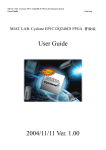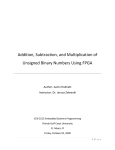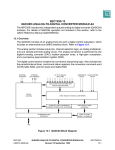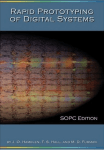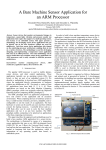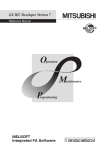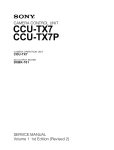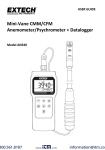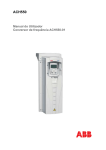Download Investigation of Altera DE2 Development and Education Board
Transcript
Investigation of Altera DE2 Development and Education Board COP 4902 Independent Study Joseph Voelmle 1/20/2009 1 INTRODUCTION TO FPGAS ................................................................................................................................. 2 1.1 BASIC THEORY .......................................................................................................................................... 2 1.2 BASICS OF PLAS ........................................................................................................................................ 5 1.3 OTHER FPDS ............................................................................................................................................. 8 1.4 BASICS OF FPGAS ................................................................................................................................... 10 2 DEVELOPMENT WITH THE ALTERA DE2 EVALUATION BOARD .......................................................................... 19 2.1 H/W AND S/W CONFIGURATION............................................................................................................ 19 2.1.1 HARDWARE DESCRIPTION ...................................................................................................................... 19 2.1.2 SOFTWARE DESCRIPTION ....................................................................................................................... 22 2.1.3 PROGRAM DESIGN FLOW ....................................................................................................................... 24 2.2 CASE STUDY #1 ....................................................................................................................................... 25 2.3 STEPS TO COMPILE AND UPLOAD HELLO_WORLD TO THE BOARD ......................................................... 29 2.4 CASE STUDY #2 ....................................................................................................................................... 30 3 CONCLUSION .................................................................................................................................................... 34 REFERENCES......................................................................................................................................................... 36 APPENDIX 1 ......................................................................................................................................................... 37 APPENDIX 2 ......................................................................................................................................................... 40 APPENDIX 3 ......................................................................................................................................................... 41 APPENDIX 4 ......................................................................................................................................................... 42 1 1 Introduction to FPGAs We begin by providing some background on programmable logic and the reasons for the popularity of Field Programmable Devices (FPD). There are many different types of devices and architectures the designer will encounter, and one should be familiar with the different terminology used in the field. There are a wide variety of FPDs that the designer can choose. In addition to FPDs, Programmable Logic Devices (PLDs) is another name that the designer will encounter for FPDs. FPD is a general term while PLDs historically refer to relatively simple devices. A Programmable Logic Array (PLA) is relatively small FPD consisting of two levels of logic, an AND plane followed by an OR plane, with both levels being programmable. A Programmable Array Logic (PAL) is also a relatively small FPD with a programmable AND plane followed by a fixed OR plane. (PAL is trademarked by Advanced Micro Devices.) Simple PLD (SPLD) is usually a PLA or a PAL. A Complex PLD (CPLD) consists of multiple SPLD-like blocks on a chip. A Field Programmable Gate Array (FPGA) is a FPD consisting of a very general structure allowing a very high density. 1.1 Basic Theory Combinational digital circuits are based on Boolean algebra. A common form of Boolean equations is known as canonical, two-level, product-of-sums. Here, a function can be expressed by ANDing terms together (first level) and ORing these together (second level) to form an 2 output. The advantage of this is that these functions can be readily realized by using AND gates followed by OR gates. For example, a function F = AB’C’ + A’B + BC could be implemented by: Figure 1 Circuit implementing formula F = AB’C’ + A’B + BC [14] The individual products terms, AB’C’, A’B, and BC, are known as minterms. For simple designs, this technology is sufficient, but it was found that more complex designs required other techniques. Early digital circuits were designed using discrete logic such as 7400 series of transistortransistor logic (TTL) integrated circuits. This series includes not only devices containing logic gates, such as the 7400 which contains four NAND gates, but also more complex devices such as flip-flops, counters, decoders, and multiplexers. Unlike older technologies, which relied on many small scale integration (SSI) chips such as the 7400 series, designs today consist mainly of highdensity devices. The first use of user programmable logic was realized by Programmable ReadOnly Memory (PROM), where address lines are the inputs to the logic circuit and data read from 3 those address locations form the logic circuit output. This is a form of look-up table (LUT) where we use the input to look up the output by indexing a table. (Fig. 2) Figure 2 Internal Organization of a ROM [14] As an example, Figure 3 shows a combinational logic implementation (two-level canonical form) using a PROM with the associated Boolean equations for the outputs. Figure 3 Combinational logic implementation using a ROM [14] 4 Using PROMs are advantageous when design time is short (there is no need to minimize output functions), most input combinations are needed (such as for code converters), and there is little sharing of product terms among output functions. There are however, several disadvantages. One is that the size doubles for each additional input. Logic functions rarely require more than a few product terms. Since a PROM has a full decoder we can’t take advantage of don’t cares 1 and have to account for all input combinations. PROMs are an inefficient architecture for implementing logic circuits since only a fraction of their capacity is used in any one application. For these reasons, they are rarely used for this purpose. 1.2 Basics of PLAs Programmable Logic Arrays (PLAs) were specifically developed for implementing programmable logic circuits. A PLA contains a programmable AND array or plane followed by a programmable OR plane. Figure 4 Programmable Logic Array [14] 1 Don’t cares occur when certain input conditions will never occur or the output will not be changed by those input conditions. This can be used to simplify functions by reducing the number of minterms. 5 In Figure 4, we can see that the general organization of a PLA is similar to that of a PROM. Exploiting the regular structure of two level logic introduced in the previous section, PLAs arrange the AND and OR gates into a generalized structure whose connections can be programmed to implement a particular function. The AND array is used to compute the particular minterm and the OR array ORs these terms together to form the final product-of-sums output. Figure 5 PLA connections before programming [14] In order to program the PLA, selected connections between wires in a circuit like the one in Fig. 5, are open or closed by a programmable switch. Suppose we wish to implement the following logic equations: F0 F1 F2 F3 = = = = 6 A + B’C’ AC’ + AB B’C’ + AB B’C + A Exploiting the fact that some of the minterms are used more than once, we could program a PLA to implement these equations as follows, as illustrated in Fig 6. Figure 6 Example of a programmed PLA [14] A short-hand notation for describing the topology of array logic shows connection between wires as x’s and multiple wires entering gates as single wires, as illustrated in Fig 7. Figure 7 Short-hand notation of a programmed PLA [14] 7 1.3 Other FPDs When first introduced in the early 1970s, PLA were expensive and slow due to the programmable AND arrays and OR arrays. The programmable logic planes were difficult to manufacture and suffered from significant propagation delays. In 1978 Monolithic Memories introduced PALs. Like PLAs, PALs have a programmable AND array, but differ from PLAs in having a fixed OR array (Fig. 8). To overcome the lack of flexibility in not being able to program the OR array, PALs come in a variety of standard dual in-line packages (DIP) with different combinations of inputs and outputs. PALs were very important when they were introduced because they overcame many of the problems of the earlier PLAs. Being less expensive, faster, and more reliable, they proved very popular with designers. A single PLA could replace dozens of 7400 family devices. In categorizing FPDs, PLAs and PALs are called Simple PLDs (SPLDs). Industry standard SPLDs are the 16R8 and 22V10 PALs produced by AMD. Here, 16R8 means 16 inputs and a maximum of 8 outputs. R means that the output is “registered” by a D flip-flop. 22V10 means 22 inputs, 10 outputs, and V is for a versatile output, with some outputs registered and some not. Figure 8 Structure of a PAL [11] 8 As technology advanced, CPLD devices with more capability evolved. Essentially, multiple SPLDs blocks are integrated onto a chip with programmable interconnections linking these blocks. First pioneered by Altera, CPLDs provide the logic capacity of up to 50 SPLDs. CPLDs are more sophisticated than SPLDs, even at the SPLD level. An example is the AMD Mach family of CPLDs. Figure 9 Structure of AMD Mach 4 CPLD [11] Figure 9 shows the layout of the Mach 4. It consists of multiple 34V16 PAL-like blocks and the Central Switch Matrix which connects these blocks together. When we say “PAL-like” we mean that the PAL blocks are equivalent to the 34V16 PAL but are designed to give the user more flexibility than a regular PAL. All connections between PAL blocks are routed through the Central Switch Matrix which allows the Mach 4 to be viewed not only as a collection of PALs but also as a single device. 16 PAL blocks on the chip correspond to approximately 5000 logic 9 gates. This is still not sufficient for modern applications that require many thousands of gates on a chip. FPGAs seem to solve that problem. 1.4 Basics of FPGAs To examine FPGAs, we first need to discuss gate arrays. Gate arrays are an approach used in the design and manufacture of Application-Specific Integrated Circuits (ASICs). In a gate array, transistors, or basic logic gates such as NAND or NOR gates, or other active devices, are placed at regular, predefined positions on an integrated circuit (Fig. 10). A circuit with a specified function is realized when a layer or layers of interconnects between the different logic elements are added to the chip late in the manufacturing process. Extending the PLA/PAL concept, gate arrays allow a general form of programmable wires on a chip. This removes the restriction of having gates arranged in a two level AND-OR form. This is a more expensive and time consuming to manufacture, but can achieve gates densities in the millions and speeds much greater than PLAs/PALs. Figure 10 General Structure of a Gate Array [14] 10 Today, most prototypes, and many production designs use Field Programmable Devices (FPDs) and FPGAs in particular. An FPGA or field-programmable gate array is a semiconductor device containing basic programmable logic components called "logic blocks", and wires between those blocks. Unlike gate arrays, whose wires must be manufactured on to the chip, the wires on FPGAs are programmable as well. FPGA logic blocks and wires can be programmed in the field (hence the name) very rapidly which makes it the premier technology for prototyping. Logic blocks can be programmed to perform the function of basic logic gates such as AND, and XOR, or more complex combinational functions such as decoders or mathematical functions. In most FPGAs, the logic blocks also include memory elements, which may be simple flip-flops or more complete blocks of memory. 1, 2 FPGAs combine the density advantages of gate arrays with the programmability of PALs/PLAs. The advantages of FPGAs are low start-up costs, a shorter time to market, lower non-recurring engineering costs, instant manufacturing turnaround, low financial risk, and ease of design changes due to ability to re-program in the field to fix bugs. Disadvantages of FPGAs are that they are usually slower than ASICs, draw more power, and cannot handle as complex a design. With a myriad of different FPGAs on the market, each with a unique architecture, we will focus on Altera Cyclone II, which is used in this project. The Cyclone II family offers devices with a variety of features. The particular device on the DE2 board is the EP2C35. The Cyclone II contains a two dimensional architecture to implement custom logic (Fig. 11). Column and row interconnects of varying speeds connect logic array blocks (LABs), embedded memory blocks, and embedded multipliers. The logic array consists of LABs, with 16 logic elements (LEs) in each LAB, where an LE is the smallest unit of logic providing user logic functions. LABs are grouped into rows and columns throughout the device. The Cyclone II EP2C35 device contains 11 33,216 LEs. The Cyclone II provides a global clock network consisting of up to 16 global clock lines that drive throughout the entire device and four phase-locked loops (PLLs). The global clock network can provide clocks for all resources within the device, such as input/output elements (IOEs), LEs, embedded multipliers, and memory blocks. The EP2C35 offers 483,840 kbits of embedded memory. The EP2C35 has 105 M4K memory blocks are true dual-port memory blocks with 4K bits of memory plus parity (4,608 bits). These blocks provide dedicated memory up to 36-bits wide at up to 260 MHz and are arranged in columns across the device in between certain LABs. The EP2C35 has 35 embedded multiplier blocks each of which can implement up to either two 9 × 9-bit multipliers, or one 18 × 18-bit multiplier with up to 250MHz performance. The embedded multipliers are arranged in columns across the device. Each Cyclone II device I/O pin is fed by an IOE located at the ends of LAB rows and columns around the periphery of the device. I/O pins support various single-ended and differential I/O standards, and each IOE contains a bidirectional I/O buffer and three registers for registering input, output, and output-enable signals. The EP2C35 offers up to 475 user I/O pins. Figure 11 Cyclone II Architecture [7] 12 The LE, the smallest unit of logic in the Cyclone II architecture, provides advanced features with efficient logic utilization (Fig. 12). Each LE features: • A four-input look-up table (LUT), which is a function generator that can implement any function of four variables • A programmable register • A carry chain connection • A register chain connection • The ability to drive all types of interconnects: local, row, column, register chain, and direct link interconnects • Support for register packing • Support for register feedback Figure 12 Cyclone II LE [7] 13 Each LE’s programmable register can be configured for D, T, JK, or SR operation and has data, clock, clock enable, and clear inputs. The register’s clock and clear control signals can be driven by any signal that use the global clock network, general-purpose I/O pins, or by any internal logic. The clock enable can be driven by either general-purpose I/O pins or internal logic. For combinational functions, the LUT output bypasses the register and drives directly to the LE outputs. Each LE has three outputs that drive the local, row, and column routing resources. The LUT or the programmable register output can drive these three outputs independently. Two LE outputs drive column or row and direct link routing connections and one drives local interconnect resources, allowing the LUT to drive one output while the register drives another output. This feature, known as register packing, allows the device to use the register and the LUT for unrelated functions, thereby improving utilization. Another special mode allows the register output to feed back into the LUT of the same LE. The Cyclone II LE operates in either normal mode or arithmetic mode. Normal mode is used for general logic applications and combinational functions, while arithmetic mode is for implementing adders, counters, accumulators, and comparators. Each Logic Array Block consists of the following: • 16 LEs • LAB control signals • LE carry chains • Register chains • Local interconnect 14 The local interconnect transfers signals between LEs in the same LAB (Fig. 13). Register chain connections (Fig. 12) transfer the output of one LE’s register to the adjacent LEs register within an LAB. Figure 13 Cyclone II LAB Structure [7] The LAB local interconnect can drive LEs within the same LAB. The LAB local interconnect is driven by column and row interconnects and LE outputs within the same LAB. Neighboring LABs, PLLs, M4K memory blocks, and embedded multipliers from the left and right can also drive an LAB’s local interconnect through the direct link connection. The direct link connection feature minimizes the use of row and column interconnects, providing higher performance and flexibility. Each LE can drive 48 LEs through fast local and direct link interconnects (Fig. 14). 15 Figure 14 Direct Link Connection [7] Dedicated row interconnects route signals to and from LABs, PLLs, M4K memory blocks, and embedded multipliers within the same row, while column interconnects perform the same functions with regards to columns. The EP2C35 provides 16 global clock networks and four PLLs. The Cyclone II clock network features include: • 16 global clock networks • four PLLs • Global clock network dynamic clock source selection • Global clock network dynamic enable and disable Each global clock network has a clock control block to select from a number of input clock sources (PLL clock outputs, dedicated clock (CLK) pins, dual purpose (DPCLK) pins, and internal logic) to drive onto the global clock network (Fig. 14). DPCLK pins function the same 16 as CLK pins, but in addition can be used for signals for external memory interfaces. In addition to 16 global clock networks and four PLLs, the EP2C35 has 16 CLK pins and 20 DPCLK pins. Figure 15 PLL, CLK, DPCLK and Clock Control Block Locations [7] Notes to Figure 15: (1) There are four control blocks on each side. (2) Only one of the corner CDPCLK pins in each corner can feed the control block at a time. The other CDPCLK pins can be used as general-purpose I/O 17 The Cyclone II embedded memory consists of columns of M4K memory blocks. The M4K memory blocks include input registers that synchronize writes and output registers to pipeline designs and improve system performance. The M4K memory blocks support the following features: • • • • • • • • • • • • 4,608 RAM bits 250-MHz performance True dual-port memory Simple dual-port memory Single-port memory Byte enable Parity bits Shift register FIFO buffer ROM Various clock modes Address clock enable Figure 16 shows the M4K block to logic array interface. Figure 16 M4K RAM Block LAB Row Interface [7] 18 2 Development with the Altera DE2 Evaluation Board 2.1 H/W and S/W Configuration This section presents background information regarding the use of the Altera DE2 evaluation board and Quartus II software. The idea is to provide flexibility in running the board both at home and at school. 2.1.1 Hardware Description Figure 17 depicts the layout of the board and indicates the location of the connectors and key components. Figure 17 The DE2 Board [8] The following hardware is provided on the DE2 board: • Altera Cyclone® II 2C35 FPGA device • Altera Serial Configuration device - EPCS16 19 • USB Blaster (on board) for programming and user API control; both JTAG and Active Serial (AS) programming modes are supported • 512-Kbyte SRAM • 8-Mbyte SDRAM • 4-Mbyte Flash memory • SD Card socket • 4 pushbutton switches • 18 toggle switches • 18 red user LEDs • 9 green user LEDs • 50-MHz oscillator and 27-MHz oscillator for clock sources • 24-bit CD-quality audio CODEC with line-in, line-out, and microphone-in jacks • VGA DAC (10-bit high-speed triple DACs) with VGA-out connector • TV Decoder (NTSC/PAL) and TV-in connector • 10/100 Ethernet Controller with a connector • USB Host/Slave Controller with USB type A and type B connectors • RS-232 transceiver and 9-pin connector • PS/2 mouse/keyboard connector • IrDA transceiver • Two 40-pin Expansion Headers with diode protection Figure 18 gives the block diagram of the DE2 board and Table 1 gives the DE2 Board information. In order to provide maximum flexibility, all connections are made through the Cyclone II FPGA device. This allows the user to configure the FPGA to implement any system design. Figure 18 DE2 Block Diagram [8] 20 Before installing software, a power up of board was performed by installing the 9V AC adapter in the 9V DC Power Supply Connector (see Fig. 17). At this point the following was observed, as a factory setup: • All user LEDs were flashing • All 7-segment displays cycled through the numbers 0 to F • The LCD display showed Welcome to the Altera DE2 Board Table 1 DE2 Board Information [3] 21 2.1.2 Software Description The Altera software consists of: • • • • Quartus II Design Suite MegaCore IP Library Nios II Embedded Design Suite ModelSim – Altera 6.1g Web Edition Once installation is complete, the Quartus II software graphical user interface is used to perform all stages of the design flow. Figure 19 shows the Quartus II GUI as it appears when you first start the software. Figure 19 Quartus II Graphical User Interface [4] The Quartus II software can be installed in evaluation mode, meaning that the software could be used for an evaluation period of 30 days. This is because running the software in normal mode requires a full license from Altera. The main problem with evaluation mode is that it does 22 not allow the user to generate *.sof files, which are the binary files generated from the VHDL compiler. What this means is that the user can write and compile VHDL programs to check for syntax errors, but is unable to upload those programs to run on the FPGA board. Thus a full license is required in the form of a data file, which is used by the software to run in normal mode (see Appendix 1). The Altera license incorporates the physical address of each computer in the licensing file. To request a license, the user must supply to Altera an NIC (network interface card) ID, which is a 12 character hexadecimal string imbedded in the network interface card. Altera uses it to uniquely identify the PC where the software is installed. To get the NIC ID, type ipconfig/all from a DOS command line on your computer. The NIC ID is the physical address without the dashes, as shown in the following printout: C:\>ipconfig/all Windows IP Configuration Host Name . . . . . . . Primary Dns Suffix . . Node Type . . . . . . . IP Routing Enabled. . . WINS Proxy Enabled. . . DNS Suffix Search List. . . . . . . . . . . . . . . . . . . . . . . . . . . . . . . : : : : : : Joe Connection-specific DNS Suffix Description . . . . . . . . . . Physical Address. . . . . . . . Dhcp Enabled. . . . . . . . . . Autoconfiguration Enabled . . . IP Address. . . . . . . . . : : : : : gateway.2wire.net Intel(R) PRO/100 VE Network Connection 00-15-17-5C-35-11 Yes Yes Broadcast No No gateway.2wire.net Ethernet adapter Local Area Connection: The NIC ID would therefore be 0015175c3511. With this information, a license can be requested for at http://www.altera.com/support/licensing/lic-university.html. An email should be received within 24 hours which has the license as an attachment (see Appendix 1). installation, the licensing setup procedures as outlined by Altera should be followed.5 23 For 2.1.3 Program Design Flow The Quartus II design software provides a design environment that includes sample solutions for all phases of FPGA design (Fig 20). Figure 20 Quartus II Design Flow [4] Figure 21 shows the Quartus II program design flow, with the files that are generated by the compiler and assembler. 24 Figure 21 Program Design Flow [4] 2.2 Case Study #1 Part of initial evaluation was to compile and upload a “hello world” program which was written by Martin Schoeberl8. This program makes an LED blink at a certain frequency. The instructions that come with the program make mention of an EP1C6Q240C8 and EP1C12Q240C8 FPGA device. However, the FPGA on the Altera DE2 board is an EP2C35F672C6. The instructions give pin assignments that don’t exist with our system. The pin assignments are listed in the DE2 Development and Education Board User Manual [8]. A search also yielded an Excel file called DE2_pin_assignments.csv [10] which listed the needed pin assignments (see Appendix 4). Using this information, it was decided to arbitrarily select LEDG0 (green LED #0) to blink (see Fig. 22), which corresponded to pin assignment PIN_AE22 and pin PIN_D13 for the clock. Using these pin assignments, the hello_world program was compiled without errors. 25 LEDG0 Figure 22 Altera DE2 Developments and Education Board [3] Appendix 2 contains the listing for the hello_world.vhd program. This program is written in VHDL which stands for VHSIC Hardware Descriptive Language. (VHSIC stands for VeryHigh-Speed Integrated Circuits, a United States Department of Defense program.) A digital system can be represented at different levels of abstraction, behavioral and structural. The behavioral level describes what a system does in terms of input and output signals. The structural level is a lower level of abstraction which describes a system as a collection of gates and components that are interconnected and is analogous to a schematic of interconnected logic gates. The hello_world program represents a behavioral description. All VHDL systems consist of design entities which in turn consist of other entities. Each entity is modeled by an entity declaration and an architecture body. The entity declaration is the interface to the outside world that defines the input and output signals, while the architecture body contains the description of the entity and is composed of interconnected entities, processes and components, all operating concurrently13. Referring to the appendix, the first few lines are comments, denoted by --. 26 The next three lines library ieee; use ieee.std_logic_1164.all; use ieee.numeric_std.all; declare libraries needed for simple logic functions. These libraries permit use of predefined logic values, logic operations like AND, OR, and arithmetic operations like + (add) etc. The following statements entity hello_world is port ( clk : in std_logic; led : out std_logic ); end hello_world; give the external view of our device. Entity names the device (hello_world), while port declares any input and output signal. Here clk is declared as an input and led is declared as an output. The next statement architecture rtl of hello_world is begins the architectural description of our device, in essence how it is supposed to behave. Here, rtl is the name of our architecture and associates it with the entity hello_world. The next statements constant CLK_FREQ : integer := 20000000; constant BLINK_FREQ : integer := 1; constant CNT_MAX : integer := CLK_FREQ/BLINK_FREQ/2-1; signal cnt : unsigned(24 downto 0); signal blink : std_logic; 27 declare constants and variables used in our program. unsigned defines a bit vector of 25 elements: unsigned(24), unsigned(23), …unsigned(0). The next statement begin process(clk) begins what is known as the process construct. A process statement is the main construct in behavioral modeling that allows you describe the behavior of a system. In the statement process(clk), clk describes the signals to which the process is sensitive. All signals within the (…) are known as the sensitivity list. A block of code is delimited by the begin and end statements. The next statements begin if rising_edge(clk) then if cnt=CNT_MAX then cnt <= (others => ’0’); blink <= not blink; else cnt <= cnt + 1; end if; end if; end process; are the statements that cause the LED to blink. Again, the code block is delimited by the begin and end process statements. The next statements checks for the rising edge of the clock. If we’ve counted the maximum number of clock pulses, then we set cnt to zero and toggle the variable blink. In the statement cnt <= (others => ’0’), others is a VHDL key word and sets cnt to ‘0’. In VHDL <= is the assignment operator and assigns the value of the expression on the right to the signal on the left. The final statement, led <= blink assigns the value of blink to led, which causes the LED to turn on or off. 28 2.3 Steps to compile and upload hello_world to the board Start Quartus II and create a new project with: 1. File – New Project Wizard... 2. Enter in for the working directory: C:\altera\70\quartus\hello_world 3. Under “What is the name of this project?” type hello_world 4. Press Next button. A message box may pop up saying “Directory “C:\altera\70\quartus\hello_world” does not exist. Do you want to create it?” Select Yes. The hello_world.vhd file listed in Appendix 2 should be placed in this directory. 5. The Wizard will next ask you to select design files to include in the project. Leave blank and just press next. 6. We are now at Family & Device Settings. For Family select Cyclone II. For Device select EP2C35F672C6. Press next. 7. For EDA tools settings, leave fields blank and press next. 8. At Summary, press finish. 9. Next, select Processing – Start Compilation. This should produce the hello_world.sof file. 10. Next, we have to select the pins we need. Select Assignments – Pins. This will bring up the Pin Planner. For led, under Location select PIN_AE22, and for clk select PIN_D13. 11. We can now program our device with the hello_world program. The board needs to be powered up and connected to the computer via the USB cable. A driver needs to be installed for the USB Blaster. Refer to Altera web site for directions.6 Select Tools - Programmer from the menu. If EP2C35F672 is not shown under device, select Add Device… Under Device Family check Cyclone II. Under Device Name check EP2C35F672. Hit OK. Check the box under Program/Configure. Select Hardware Setup… Under Available Hardware Items: Double click USB-Blaster and Click Close. 12. Create a cdf file from Quartus II File Menu. Choose New... from File menu. Click the Other Files tab. Select Chain Description File. Click OK. Click Add File. A Select Programming File 29 window will pop up. Then choose the hello_world.sof to be added. Next, remember to check the Program/Configure box. From the file menu, save hello_world.cdf file through Save button. 13. Next, select Processing – Start Compilation. 14. We are finally able to run the hello_world program on our board. From Tools Programmer hit Start. Our little green LED should blink. 2.4 - Case Study #2 The next step in this project was to write a VHDL program to implement a simple 8 bit up-down counter. Figure 23 shows the schematic. Figure 23 Up-Down Counter The counter has three inputs and eight outputs. The up_down input tells the counter in which direction to count, high to count up and low to count down. The asynch_clr input resets the resets the counter to zero. The counter will count up (or down) once with each clock at the clk input. The outputs, Q(0) through Q(7), are the 8-bit output of the counter, so that on each clk pulse, the counter will proceed sequentially from (or down from) 00000000, 00000001, 00000010, 00000011, 00000100, up to 11111111 with each clock pulse. When it reaches 11111111 it goes to 00000000 on the next clock pulse and start the sequence all over again. Appendix 3 contains the listing for the up_down_counter.vhd program. To implement this 30 program it was decided to use Q(0) through Q(7) to light LEDR[0] through LEDR[7] (See Fig. 23). The up_down input was connected to toggle switch SW[0], so that SW[0] in the up position would cause the counter to count up, and the down position would cause it to count down. The asynch_clr was connected to push button switch KEY[0] (See Fig. 23). The 50 MHz clock was used as the input to the counter. LEDR[0] –LEDR[7] SW[0] KEY[0] Figure 24 Case Study #2 [3] Referring to Appendix 3, the first few lines are comments, followed by the three lines declaring the libraries. The next few lines entity up_down_counter is port (clk, up_down, asynch_clr: in std_logic; Q: out std_logic_vector(7 downto 0) ); end up_down_counter; declare our entity as up_down_counter with the inputs as clk, up_down, and asynch_clr. The outputs are Q(7) through Q(0). The next line architecture counter_behavior of up_down_counter is 31 begins the architectural body that specifies how the up_down counter operates and how it is implemented. The next few lines constant CLK_FREQ : integer := 50000000; -- use PIN_N2 for 50MHz clock constant BLINK_FREQ : integer := 5; constant CNT_MAX : integer := CLK_FREQ/BLINK_FREQ; declare constant values used in the program. CNT_MAX is used to delay the blinking of the LEDs so that they will be visible to the user. The next lines signal count: std_logic_vector(7 downto 0); signal cnt : unsigned(24 downto 0); declare signals count and cnt which are used in the program. Signals are similar to variables but have a delay during assignments whereas variable assignments are instantaneous. The lines begin and end architecture counter_behavior; delimit the block of code that describes the behavior of the counter. The next line process(clk, asynch_clr) -- sensitivity list is the process statement. A process statement is the main construct in behavioral modeling that allows the use of sequential statements to describe the behavior of a system over time. The inputs clk and asynch_clr within the left and right parenthesis are called the sensitivity list. The sensitivity list is the set of signals to which the process is sensitive. Any change in the value of the signals in the sensitivity list, in this case clk and asynch_clr, will cause immediate execution of the process. 32 The next lines begin if (asynch_clr='0') then -- asynch_clr is Pushbutton[0] count <= "00000000"; elsif (rising_edge(clk)) then -- after so many clocks, increment/decrement count if cnt=CNT_MAX then cnt <= (others => '0'); -- up_down is Toggle Switch[0], up position count up, -- down count down if (up_down='1') then count <= count + "00000001"; else count <= count - "00000001"; end if; else cnt <= cnt + 1; end if; end if; end process; Q <= count; are how the counter actually behaves. The counter begins at 00000000 binary. After 10 million clock pulses, we increment or decrement our counter by one and load the count value into the Q outputs of the counter. This is so that the blinking of the LEDs will be visible, the least significant bit blinking off and on every 0.2 seconds. Using the procedure described for the hello_world program in Section 2.3, the up_down_counter.vhd program should now be compiled and loaded on the Altera board. The pin assignments will be as follows: asynch_clr: PIN_G26, clk: PIN_N2, Q[7]: PIN_AC21, Q[6]: PIN_AD21, Q[5]: PIN_AD23, Q[4]: PIN_AD22, Q[3]: PIN_AC22, Q[2]: PIN_AB21, Q[1]: PIN_AF23, Q[0]: PIN_AE23, and up_down: PIN_N25. This should result in LED[0] through LED[7] blinking in sequence from 00000000 through 11111111. 33 3 Conclusion The DE2 board features a Cyclone II EP2C35 FPGA. The user can control all aspects of the board’s operation since all important components on the board are connected to the pins of the Cyclone II. The DE2 board includes toggle and push-button switches, LEDs, and 7-segment displays for use in simple experiments. SRAM, SDRAM, and Flash memory chips, as well as a 16 x 2 character display can be used in more advanced experiments. A design suite to instantiate Altera’s Nios II embedded processor is included, which would allow for experiments that require a processor and provide a vehicle for learning about topics in computer organization. The Nios II IDE should be easy to use for anyone familiar with the Eclipse IDE since it is based on the Eclipse IDE framework. The DE2’s I/O interfaces include standards such as RS-232 and PS/2. There are standard connectors for microphone, line-in, line-out (24-bit audio CODEC), video-in (TV Decoder), and VGA (10-bit DAC). These can be used in experiments involving sound or video signals to create CD-quality audio applications and professional-looking video. The DE2 provides USB 2.0 connectivity, 10/100 Ethernet, an infrared (IrDA) port, and an SD memory card connector for larger design projects. For projects requiring more than one board, other user defined boards can be connected to the DE2 board by means of two expansion headers. In this report, we have only scratched the surface of the capabilities of the Altera DE2 Development and Education Board. The purpose of the Altera DE2 Development and Education board is to provide a vehicle for learning about digital logic, computer organization, and FPGAs. It uses state-of-the-art technology in both hardware and CAD tools to give users a wide range of topics to explore. The board offers features that make it suitable for use for a variety of design projects for university courses, as well as for the development of sophisticated digital systems. 34 35 References [1] R. H. Katz and G. Borriello, Contemporary Logic Design, 2nd Edition, Prentice Hall pp. 160-161 [2] Wikipedia, Complex programmable logic device, Programmable Array Logic, Programmable logic device, Field-programmable gate array, Gate array, 7400 series [3] DE2 Development and Education Board, Altera Corp. San Jose, CA, 2009, www.altera.com/education/univ/materials/boards/unv-de2-board.html [4] Introduction to the Quartus® II Software, Version 8.0, Altera Corp. San Jose, CA, www.altera.com/literature/manual/intro_to_quartus2.pdf [5] Altera Software Licensing, AN-340.2.1, Altera Corp. San Jose, CA, November 2008, www.altera.com/literature/an/an340.pdf [6] USB-Blaster Driver for Windows XP, Altera Corp. San Jose, CA, 2009, www.altera.com/support/software/drivers/usb-blaster/dri-usb-blaster-xp.html [7] Cyclone II Device Handbook, Volume 1, CII5V13.3, Altera Corp. San Jose, CA, February 2008, www.altera.com/literature/hb/cyc2/cyc2_cii5v1.pdf [8] DE2 Development and Education Board User Manual, Version 1.4, Altera Corp. San Jose, CA, 2006, ftp://ftp.altera.com/up/pub/Webdocs/DE2_UserManual.pdf [9] M. Schoeberl, The FPGA Hello World Example, August 4, 2006, www.jopdesign.com/cyclone/hello_world.pdf [10] DE2 Pin Assignments, Cornell University, September 28, 2005, http://courses.cit.cornell.edu/ece576/DE2/DE2_pin_assignments.csv [11] S. Brown and J. Rose, Architecture of FPGAs and CPLDs: A Tutorial, University of Toronto, Department of Electrical and Computer Engineering, 1996, http://www.eecg.toronto.edu/~jayar/pubs/brown/survey.pdf [12] S. Brown and J. Rose, FPGA and CPLD Architectures: A Tutorial, IEEE Design & Test of Computers, Vol. 13, No 2, pp. 42-57, 1996 [13] J. Van der Spiegel, VHDL Tutorial, University of Pennsylvania, Department of Electrical and Systems Engineering, August 6, 2006, www.seas.upenn.edu/~ese201/vhdl/vhdl_primer.html [14] R. H. Katz, UC Berkeley Computer Science 150 Components and Design Technique Digital Systems lecture slides, Fall 2000, http://bnrg.cs.berkeley.edu/~randy/Courses/CS150.F00/ 36 Appendix 1 Date: Thu, 18 Sep 2008 09:28:43 -0700 From: http://www.google.com/[email protected] To: <[email protected]> Subject: Your Altera Development Tools License Dear JOSEPH VOELMLE, Thank you for requesting a license file to enable your Altera Quartus II software. Quartus II software delivers the highest average performance for FPGA and CPLD designs. ********************************************* Quartus II Software - #1 in Performance Details at http://www.altera.com//alterazone ********************************************* This email includes the following sections: *Extensive Learning Resources *License File Installation Instructions *Support Information EXTENSIVE LEARNING RESOURCES The Quartus II software is the easiest to use software for FPGA, CPLD, and structured ASIC devices. Extensive resources are available to help you become productive immediately including: 1. Online video demonstrations at http://www.altera.com//quartusdemos. 2. Free online training classes at http://www.altera.com//etraining. 3. Introduction to Quartus II Manual, Quartus II Handbook, and Quartus II Scripting Reference Manual at http://www.altera.com/literature/lit-qts.jsp. 4. Tutorials included in the Quartus II software under the Help menu. License File Installation Intructions Your license: FEATURE quartus_lite alterad 2009.02 15-feb-2009 uncounted \ 9CEC128DF1C9 HOSTID=0015175c3511 SIGN="01F5 00E9 D850 DB0C \ 37 A1C2 AA87 7813 4AF7 FA73 7205 724C CC22 D2EC 4BB5 EE96 0A70 \ 2D1D F8EA 80C3 71C0 4C0E 35F9 1F2D 91A6 3503 CAF6 31A6 6323 \ C9FB 232B" INCREMENT alteramtiwe mgcld 2009.02 15-feb-2009 uncounted \ 7DB92132FD6F375109BB VENDOR_STRING=00F33221 HOSTID=0015175c3511 \ SUPERSEDE ISSUER=Alterav3.5 Your license file(s) is also attached to this e-mail as a text file. PC Instructions 1. Save your license file text to your computer's hard drive. Altera recommends saving the file into your c:/quartus directory with a ".dat" file name extension. 2. In the Quartus II software, choose License Setup (Tools Menu). 3. In the License File box type or browse to the full path and file name of the file you saved in step 1. 4. If you have problems, use AN 340 to troubleshoot your licensing setup. ADDITIONAL LICENSING AND INSTALLATION INFORMATION The following documents offer detailed licensing and installation instructions: **AN 340 - Altera Software Licensing <http://www.altera.com/literature/an/an340.pdf> **Quartus II Installation & Licensing for PCs Manual <http://www.altera.com/literature/manual/quartus_install.pdf> Support INFORMATION If you have further questions, you may file a Service Request at <https://mysupport.altera.com/>. If you are not yet registered, have your licensing information available for an expedited sign-up. You may sign up as a new user to get the same service. Confidentiality Notice. This message may contain information that is confidential or otherwise protected from 38 disclosure. If you are not the intended recipient, you are hereby notified that any use, disclosure, dissemination, distribution, or copying of this message, or any attachments, is strictly prohibited. If you have received this message in error, please advise the sender by reply e-mail, and delete the message and any attachments. Thank you. Attachment 1: 0015175C3511__0-672602176048142.dat (421Byte) Delete 0-1 a Type: application/octet-stream Encoding: 7bit 39 Download Appendix 2 --- hello_world.vhd --- The ’Hello World’ example for FPGA programming. --- Author: Martin Schoeberl ([email protected]) --- 2006-08-04 created -library ieee; use ieee.std_logic_1164.all; use ieee.numeric_std.all; entity hello_world is port ( clk : in std_logic; led : out std_logic ); end hello_world; architecture rtl of hello_world is constant CLK_FREQ : integer := 20000000; constant BLINK_FREQ : integer := 1; constant CNT_MAX : integer := CLK_FREQ/BLINK_FREQ/2-1; signal cnt : unsigned(24 downto 0); signal blink : std_logic; begin process(clk) begin if rising_edge(clk) then if cnt=CNT_MAX then cnt <= (others => ’0’); blink <= not blink; else cnt <= cnt + 1; end if; end if; end process; led <= blink; end rtl; 40 Appendix 3 -- up_down_counter.vhd -- COP 4908 Independent Studies Joseph Voelmle -library ieee ; use ieee.std_logic_1164.all ; use ieee.std_logic_arith.all ; use ieee.std_logic_unsigned.all; entity up_down_counter is port (clk, up_down, asynch_clr: in std_logic; Q: out std_logic_vector(7 downto 0) ); end up_down_counter; architecture counter_behavior of up_down_counter is -- the following lines are used as a delay to the counter so that -- the output of the counter could be visible to the user constant CLK_FREQ : integer := 50000000; -- use PIN_N2 for 50MHz clock constant BLINK_FREQ : integer := 5; constant CNT_MAX : integer := CLK_FREQ/BLINK_FREQ; signal count: std_logic_vector(7 downto 0); signal cnt : unsigned(24 downto 0); begin -- count is an internal signal to this process process(clk, asynch_clr) -- sensitivity list begin if (asynch_clr='0') then -- asynch_clr is Pushbutton[0] count <= "00000000"; elsif (rising_edge(clk)) then -- after so many clocks, increment/decrement count if cnt=CNT_MAX then cnt <= (others => '0'); -- up_down is Toggle Switch[0], up position count up, -- down count down if (up_down='1') then count <= count + "00000001"; else count <= count - "00000001"; end if; else cnt <= cnt + 1; end if; end if; end process; Q <= count; end architecture counter_behavior; 41 Appendix 4 # Quartus II Version 5.1 Internal Build 160 09/19/2005 TO Full Version # File: D:\de2_pins\de2_pins.csv # Generated on: Wed Sep 28 09:40:34 2005 # Note: The column header names should not be changed if you wish to import this .csv file into the Quartus II software. To SW[0] SW[1] SW[2] SW[3] SW[4] SW[5] SW[6] SW[7] SW[8] SW[9] SW[10] SW[11] SW[12] SW[13] SW[14] SW[15] SW[16] SW[17] DRAM_ADDR[0] DRAM_ADDR[1] DRAM_ADDR[2] DRAM_ADDR[3] DRAM_ADDR[4] DRAM_ADDR[5] DRAM_ADDR[6] DRAM_ADDR[7] DRAM_ADDR[8] DRAM_ADDR[9] DRAM_ADDR[10] DRAM_ADDR[11] DRAM_BA_0 Location PIN_N25 PIN_N26 PIN_P25 PIN_AE14 PIN_AF14 PIN_AD13 PIN_AC13 PIN_C13 PIN_B13 PIN_A13 PIN_N1 PIN_P1 PIN_P2 PIN_T7 PIN_U3 PIN_U4 PIN_V1 PIN_V2 PIN_T6 PIN_V4 PIN_V3 PIN_W2 PIN_W1 PIN_U6 PIN_U7 PIN_U5 PIN_W4 PIN_W3 PIN_Y1 PIN_V5 PIN_AE2 42 DRAM_BA_1 DRAM_CAS_N DRAM_CKE DRAM_CLK DRAM_CS_N DRAM_DQ[0] DRAM_DQ[1] DRAM_DQ[2] DRAM_DQ[3] DRAM_DQ[4] DRAM_DQ[5] DRAM_DQ[6] DRAM_DQ[7] DRAM_DQ[8] DRAM_DQ[9] DRAM_DQ[10] DRAM_DQ[11] DRAM_DQ[12] DRAM_DQ[13] DRAM_DQ[14] DRAM_DQ[15] DRAM_LDQM DRAM_UDQM DRAM_RAS_N DRAM_WE_N FL_ADDR[0] FL_ADDR[1] FL_ADDR[2] FL_ADDR[3] FL_ADDR[4] FL_ADDR[5] FL_ADDR[6] FL_ADDR[7] FL_ADDR[8] FL_ADDR[9] FL_ADDR[10] FL_ADDR[11] FL_ADDR[12] FL_ADDR[13] FL_ADDR[14] FL_ADDR[15] FL_ADDR[16] FL_ADDR[17] PIN_AE3 PIN_AB3 PIN_AA6 PIN_AA7 PIN_AC3 PIN_V6 PIN_AA2 PIN_AA1 PIN_Y3 PIN_Y4 PIN_R8 PIN_T8 PIN_V7 PIN_W6 PIN_AB2 PIN_AB1 PIN_AA4 PIN_AA3 PIN_AC2 PIN_AC1 PIN_AA5 PIN_AD2 PIN_Y5 PIN_AB4 PIN_AD3 PIN_AC18 PIN_AB18 PIN_AE19 PIN_AF19 PIN_AE18 PIN_AF18 PIN_Y16 PIN_AA16 PIN_AD17 PIN_AC17 PIN_AE17 PIN_AF17 PIN_W16 PIN_W15 PIN_AC16 PIN_AD16 PIN_AE16 PIN_AC15 43 FL_ADDR[18] FL_ADDR[19] FL_ADDR[20] FL_ADDR[21] FL_CE_N FL_OE_N FL_DQ[0] FL_DQ[1] FL_DQ[2] FL_DQ[3] FL_DQ[4] FL_DQ[5] FL_DQ[6] FL_DQ[7] FL_RST_N FL_WE_N HEX0[0] HEX0[1] HEX0[2] HEX0[3] HEX0[4] HEX0[5] HEX0[6] HEX1[0] HEX1[1] HEX1[2] HEX1[3] HEX1[4] HEX1[5] HEX1[6] HEX2[0] HEX2[1] HEX2[2] HEX2[3] HEX2[4] HEX2[5] HEX2[6] HEX3[0] HEX3[1] HEX3[2] HEX3[3] HEX3[4] HEX3[5] PIN_AB15 PIN_AA15 PIN_Y15 PIN_Y14 PIN_V17 PIN_W17 PIN_AD19 PIN_AC19 PIN_AF20 PIN_AE20 PIN_AB20 PIN_AC20 PIN_AF21 PIN_AE21 PIN_AA18 PIN_AA17 PIN_AF10 PIN_AB12 PIN_AC12 PIN_AD11 PIN_AE11 PIN_V14 PIN_V13 PIN_V20 PIN_V21 PIN_W21 PIN_Y22 PIN_AA24 PIN_AA23 PIN_AB24 PIN_AB23 PIN_V22 PIN_AC25 PIN_AC26 PIN_AB26 PIN_AB25 PIN_Y24 PIN_Y23 PIN_AA25 PIN_AA26 PIN_Y26 PIN_Y25 PIN_U22 44 HEX3[6] HEX4[0] HEX4[1] HEX4[2] HEX4[3] HEX4[4] HEX4[5] HEX4[6] HEX5[0] HEX5[1] HEX5[2] HEX5[3] HEX5[4] HEX5[5] HEX5[6] HEX6[0] HEX6[1] HEX6[2] HEX6[3] HEX6[4] HEX6[5] HEX6[6] HEX7[0] HEX7[1] HEX7[2] HEX7[3] HEX7[4] HEX7[5] HEX7[6] KEY[0] KEY[1] KEY[2] KEY[3] LEDR[0] LEDR[1] LEDR[2] LEDR[3] LEDR[4] LEDR[5] LEDR[6] LEDR[7] LEDR[8] LEDR[9] PIN_W24 PIN_U9 PIN_U1 PIN_U2 PIN_T4 PIN_R7 PIN_R6 PIN_T3 PIN_T2 PIN_P6 PIN_P7 PIN_T9 PIN_R5 PIN_R4 PIN_R3 PIN_R2 PIN_P4 PIN_P3 PIN_M2 PIN_M3 PIN_M5 PIN_M4 PIN_L3 PIN_L2 PIN_L9 PIN_L6 PIN_L7 PIN_P9 PIN_N9 PIN_G26 PIN_N23 PIN_P23 PIN_W26 PIN_AE23 PIN_AF23 PIN_AB21 PIN_AC22 PIN_AD22 PIN_AD23 PIN_AD21 PIN_AC21 PIN_AA14 PIN_Y13 45 LEDR[10] LEDR[11] LEDR[12] LEDR[13] LEDR[14] LEDR[15] LEDR[16] LEDR[17] LEDG[0] LEDG[1] LEDG[2] LEDG[3] LEDG[4] LEDG[5] LEDG[6] LEDG[7] LEDG[8] CLOCK_27 CLOCK_50 EXT_CLOCK PS2_CLK PS2_DAT UART_RXD UART_TXD LCD_RW LCD_EN LCD_RS LCD_DATA[0] LCD_DATA[1] LCD_DATA[2] LCD_DATA[3] LCD_DATA[4] LCD_DATA[5] LCD_DATA[6] LCD_DATA[7] LCD_ON LCD_BLON SRAM_ADDR[0] SRAM_ADDR[1] SRAM_ADDR[2] SRAM_ADDR[3] SRAM_ADDR[4] SRAM_ADDR[5] PIN_AA13 PIN_AC14 PIN_AD15 PIN_AE15 PIN_AF13 PIN_AE13 PIN_AE12 PIN_AD12 PIN_AE22 PIN_AF22 PIN_W19 PIN_V18 PIN_U18 PIN_U17 PIN_AA20 PIN_Y18 PIN_Y12 PIN_D13 PIN_N2 PIN_P26 PIN_D26 PIN_C24 PIN_C25 PIN_B25 PIN_K4 PIN_K3 PIN_K1 PIN_J1 PIN_J2 PIN_H1 PIN_H2 PIN_J4 PIN_J3 PIN_H4 PIN_H3 PIN_L4 PIN_K2 PIN_AE4 PIN_AF4 PIN_AC5 PIN_AC6 PIN_AD4 PIN_AD5 46 SRAM_ADDR[6] SRAM_ADDR[7] SRAM_ADDR[8] SRAM_ADDR[9] SRAM_ADDR[10] SRAM_ADDR[11] SRAM_ADDR[12] SRAM_ADDR[13] SRAM_ADDR[14] SRAM_ADDR[15] SRAM_ADDR[16] SRAM_ADDR[17] SRAM_DQ[0] SRAM_DQ[1] SRAM_DQ[2] SRAM_DQ[3] SRAM_DQ[4] SRAM_DQ[5] SRAM_DQ[6] SRAM_DQ[7] SRAM_DQ[8] SRAM_DQ[9] SRAM_DQ[10] SRAM_DQ[11] SRAM_DQ[12] SRAM_DQ[13] SRAM_DQ[14] SRAM_DQ[15] SRAM_WE_N SRAM_OE_N SRAM_UB_N SRAM_LB_N SRAM_CE_N OTG_ADDR[0] OTG_ADDR[1] OTG_CS_N OTG_RD_N OTG_WR_N OTG_RST_N OTG_DATA[0] OTG_DATA[1] OTG_DATA[2] OTG_DATA[3] PIN_AE5 PIN_AF5 PIN_AD6 PIN_AD7 PIN_V10 PIN_V9 PIN_AC7 PIN_W8 PIN_W10 PIN_Y10 PIN_AB8 PIN_AC8 PIN_AD8 PIN_AE6 PIN_AF6 PIN_AA9 PIN_AA10 PIN_AB10 PIN_AA11 PIN_Y11 PIN_AE7 PIN_AF7 PIN_AE8 PIN_AF8 PIN_W11 PIN_W12 PIN_AC9 PIN_AC10 PIN_AE10 PIN_AD10 PIN_AF9 PIN_AE9 PIN_AC11 PIN_K7 PIN_F2 PIN_F1 PIN_G2 PIN_G1 PIN_G5 PIN_F4 PIN_D2 PIN_D1 PIN_F7 47 OTG_DATA[4] OTG_DATA[5] OTG_DATA[6] OTG_DATA[7] OTG_DATA[8] OTG_DATA[9] OTG_DATA[10] OTG_DATA[11] OTG_DATA[12] OTG_DATA[13] OTG_DATA[14] OTG_DATA[15] OTG_INT0 OTG_INT1 OTG_DACK0_N OTG_DACK1_N OTG_DREQ0 OTG_DREQ1 OTG_FSPEED OTG_LSPEED TDI TCS TCK TDO TD_RESET VGA_R[0] VGA_R[1] VGA_R[2] VGA_R[3] VGA_R[4] VGA_R[5] VGA_R[6] VGA_R[7] VGA_R[8] VGA_R[9] VGA_G[0] VGA_G[1] VGA_G[2] VGA_G[3] VGA_G[4] VGA_G[5] VGA_G[6] VGA_G[7] PIN_J5 PIN_J8 PIN_J7 PIN_H6 PIN_E2 PIN_E1 PIN_K6 PIN_K5 PIN_G4 PIN_G3 PIN_J6 PIN_K8 PIN_B3 PIN_C3 PIN_C2 PIN_B2 PIN_F6 PIN_E5 PIN_F3 PIN_G6 PIN_B14 PIN_A14 PIN_D14 PIN_F14 PIN_C4 PIN_C8 PIN_F10 PIN_G10 PIN_D9 PIN_C9 PIN_A8 PIN_H11 PIN_H12 PIN_F11 PIN_E10 PIN_B9 PIN_A9 PIN_C10 PIN_D10 PIN_B10 PIN_A10 PIN_G11 PIN_D11 48 VGA_G[8] VGA_G[9] VGA_B[0] VGA_B[1] VGA_B[2] VGA_B[3] VGA_B[4] VGA_B[5] VGA_B[6] VGA_B[7] VGA_B[8] VGA_B[9] VGA_CLK VGA_BLANK VGA_HS VGA_VS VGA_SYNC I2C_SCLK I2C_SDAT TD_DATA[0] TD_DATA[1] TD_DATA[2] TD_DATA[3] TD_DATA[4] TD_DATA[5] TD_DATA[6] TD_DATA[7] TD_HS TD_VS AUD_ADCLRCK AUD_ADCDAT AUD_DACLRCK AUD_DACDAT AUD_XCK AUD_BCLK ENET_DATA[0] ENET_DATA[1] ENET_DATA[2] ENET_DATA[3] ENET_DATA[4] ENET_DATA[5] ENET_DATA[6] ENET_DATA[7] PIN_E12 PIN_D12 PIN_J13 PIN_J14 PIN_F12 PIN_G12 PIN_J10 PIN_J11 PIN_C11 PIN_B11 PIN_C12 PIN_B12 PIN_B8 PIN_D6 PIN_A7 PIN_D8 PIN_B7 PIN_A6 PIN_B6 PIN_J9 PIN_E8 PIN_H8 PIN_H10 PIN_G9 PIN_F9 PIN_D7 PIN_C7 PIN_D5 PIN_K9 PIN_C5 PIN_B5 PIN_C6 PIN_A4 PIN_A5 PIN_B4 PIN_D17 PIN_C17 PIN_B18 PIN_A18 PIN_B17 PIN_A17 PIN_B16 PIN_B15 49 ENET_DATA[8] ENET_DATA[9] ENET_DATA[10] ENET_DATA[11] ENET_DATA[12] ENET_DATA[13] ENET_DATA[14] ENET_DATA[15] ENET_CLK ENET_CMD ENET_CS_N ENET_INT ENET_RD_N ENET_WR_N ENET_RST_N IRDA_TXD IRDA_RXD SD_DAT SD_DAT3 SD_CMD SD_CLK GPIO_0[0] GPIO_0[1] GPIO_0[2] GPIO_0[3] GPIO_0[4] GPIO_0[5] GPIO_0[6] GPIO_0[7] GPIO_0[8] GPIO_0[9] GPIO_0[10] GPIO_0[11] GPIO_0[12] GPIO_0[13] GPIO_0[14] GPIO_0[15] GPIO_0[16] GPIO_0[17] GPIO_0[18] GPIO_0[19] GPIO_0[20] GPIO_0[21] PIN_B20 PIN_A20 PIN_C19 PIN_D19 PIN_B19 PIN_A19 PIN_E18 PIN_D18 PIN_B24 PIN_A21 PIN_A23 PIN_B21 PIN_A22 PIN_B22 PIN_B23 PIN_AE24 PIN_AE25 PIN_AD24 PIN_AC23 PIN_Y21 PIN_AD25 PIN_D25 PIN_J22 PIN_E26 PIN_E25 PIN_F24 PIN_F23 PIN_J21 PIN_J20 PIN_F25 PIN_F26 PIN_N18 PIN_P18 PIN_G23 PIN_G24 PIN_K22 PIN_G25 PIN_H23 PIN_H24 PIN_J23 PIN_J24 PIN_H25 PIN_H26 50 GPIO_0[22] GPIO_0[23] GPIO_0[24] GPIO_0[25] GPIO_0[26] GPIO_0[27] GPIO_0[28] GPIO_0[29] GPIO_0[30] GPIO_0[31] GPIO_0[32] GPIO_0[33] GPIO_0[34] GPIO_0[35] GPIO_1[0] GPIO_1[1] GPIO_1[2] GPIO_1[3] GPIO_1[4] GPIO_1[5] GPIO_1[6] GPIO_1[7] GPIO_1[8] GPIO_1[9] GPIO_1[10] GPIO_1[11] GPIO_1[12] GPIO_1[13] GPIO_1[14] GPIO_1[15] GPIO_1[16] GPIO_1[17] GPIO_1[18] GPIO_1[19] GPIO_1[20] GPIO_1[21] GPIO_1[22] GPIO_1[23] GPIO_1[24] GPIO_1[25] GPIO_1[26] GPIO_1[27] GPIO_1[28] PIN_H19 PIN_K18 PIN_K19 PIN_K21 PIN_K23 PIN_K24 PIN_L21 PIN_L20 PIN_J25 PIN_J26 PIN_L23 PIN_L24 PIN_L25 PIN_L19 PIN_K25 PIN_K26 PIN_M22 PIN_M23 PIN_M19 PIN_M20 PIN_N20 PIN_M21 PIN_M24 PIN_M25 PIN_N24 PIN_P24 PIN_R25 PIN_R24 PIN_R20 PIN_T22 PIN_T23 PIN_T24 PIN_T25 PIN_T18 PIN_T21 PIN_T20 PIN_U26 PIN_U25 PIN_U23 PIN_U24 PIN_R19 PIN_T19 PIN_U20 51 GPIO_1[29] GPIO_1[30] GPIO_1[31] GPIO_1[32] GPIO_1[33] GPIO_1[34] GPIO_1[35] PIN_U21 PIN_V26 PIN_V25 PIN_V24 PIN_V23 PIN_W25 PIN_W23 52





















































